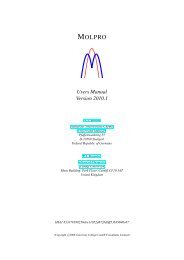CHAPTER II. POTENTIOMETRY AND REDOX TITRATIONS I ...
CHAPTER II. POTENTIOMETRY AND REDOX TITRATIONS I ...
CHAPTER II. POTENTIOMETRY AND REDOX TITRATIONS I ...
- No tags were found...
You also want an ePaper? Increase the reach of your titles
YUMPU automatically turns print PDFs into web optimized ePapers that Google loves.
Pt2H + + 2e ←⎯→ H 2 ;E° = 0 Vii/. Calomel ElectrodeFIGURE 2-2. “Harris” Fig. 15-5 (p. 317).Hg⎪Hg 2 Cl 2 (sat’d), KCl(x M)⎟⎜Hg 2 Cl 2 + 2e = 2Hg(l) + 2Cl − ; E° = +0.2682 VE(sat’d KCl) = +0.2415 VThe potential is governed by Cl − ion activity.The most common type is saturated calomel electrode (SCE).iii/. Silver/Silver Chloride ElectrodeFIGURE 2-3. “Harris” Fig. 15-3 (p. 316).Ag⎪AgCl(sat’d), KCl(x M)⎟⎜AgCl(s) + e = Ag(s) + Cl − ;The potential is governed by Cl − ion activity.E° = +0.2223 VE(sat’d KCl) = +0.197 V<strong>II</strong>I. Indicator Electrodes(A) Metallic indicator electrodesMetal electrodes develop an electric potential in response to a redox reaction at themetal surface, e.g., Pt, Au, and C, they are relatively inert.(B) Ion-Selective Electrodes (ISE)i/. Thermodynamics of ISEsISEs do not involve redox processes and often have a thin membrane ideallycapable of binding only the intended ion.FIGURE 2-4. “Harris” Fig. 15-8 (p. 383).−RT⋅In(a 1 /a 2 ) = −nFE∆G due to activity difference∆G due to charge imbalance2











![Hetero [6+3] Cycloaddition of Fulvenes with N-Alkylidene Glycine ...](https://img.yumpu.com/35423358/1/190x245/hetero-6-3-cycloaddition-of-fulvenes-with-n-alkylidene-glycine-.jpg?quality=85)




